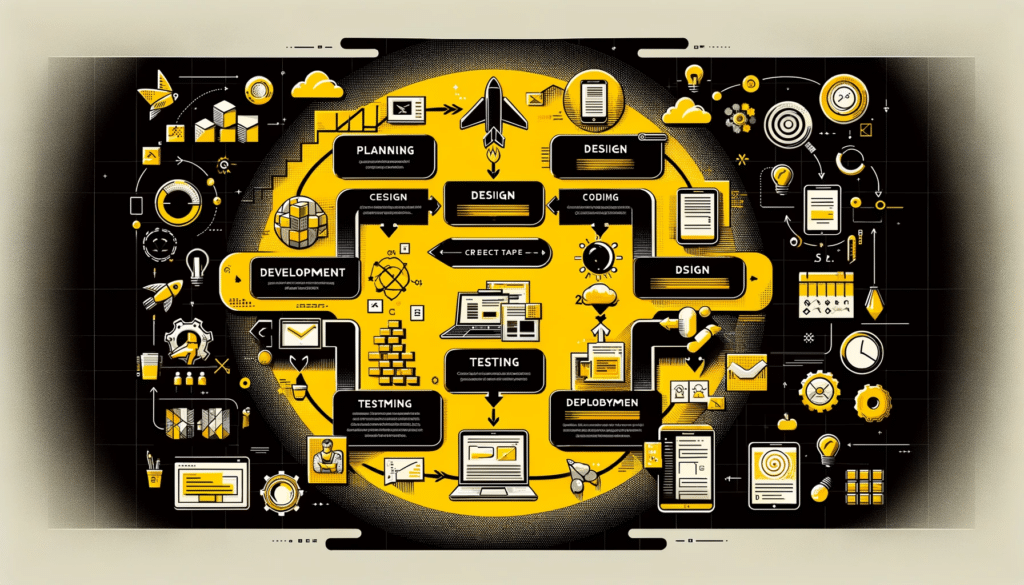

Devstars
Blog
Date: 05/11/2023
Stuart WatkinsIn the digital era, where a brand’s first impression is often its home page, developing a website is as crucial as the business it represents. This comprehensive exploration of the web development process unveils the meticulous and methodical journey from a concept to the final product.
Web development is the intricate dance of form and function, aesthetics and efficiency, which culminates in the seamless interactivity of web applications on different devices. It’s an endeavour that requires the harmonious collaboration of team members, each an expert in their field—from web designers who conjure up the visual identity to full-stack developers who encode it into reality.

The project manager orchestrates this symphony, ensuring each note resonates with the client’s needs and the end user’s expectations.
As we create a new website, it is vital to consider the information communicated and how. This initial stage is where the design team gathers insights that will inform every subsequent step.
Understanding the web development process also means recognising the significance of search engine optimisation (SEO). Hence, in a landscape dominated by search engines, a website must be designed not only to appeal to the end user but also to rank high in search results. This dual focus on the aesthetic and technical sides of web development ensures that a website is discoverable, accessible, and functional across all web browsers.
In essence, the web development process is a journey that takes a vision and transforms it into a digital reality—a reality that lives on screens across the world, inviting users to interact, explore, and connect. It’s a process that demands a blend of creativity, technical prowess, strategic planning, and a keen understanding of the ever-evolving digital landscape.

Creating a new website begins with a blueprint—a vision that encapsulates the client’s needs. Web development is the engine room where this vision is transformed into a tangible, interactive web page. The role of web development is pivotal; it is a blend of science, which lays the foundation through back-end development, and art, which breathes life into the user interface through front-end development.
The design phase is a crucial first step, where web designers envisage the colour scheme and the spatial harmony of the web page. It’s in this creative incubator that the site map is drafted, outlining the architecture of the content management system (CMS), ensuring that content creation is fluid and intuitive. It’s a step where imagination meets pragmatism, resulting in a design that is not only aesthetically pleasing but also aligns with the business logic of the client’s enterprise.
In the web development process, the design sprint methodology embodies agility and innovation. Originating from the Google Ventures team, design sprints are a five-day process for answering critical business questions through design, prototyping, and testing ideas with customers. This is particularly useful in the early stages of the design process.
The first step of a design sprint involves understanding the client’s needs and defining the challenges. It’s a day dedicated to information gathering, aligning the team’s understanding of the project goals, and mapping out the problem space.
In a design sprint, the second day is for creativity. Web designers diverge to sketch many solutions, exploring various approaches to address the identified challenges. By day’s end, decisions are made on the best way forward, often through critique and convergence.
The midpoint of the sprint is where ideas become tangible. A high-fidelity prototype that mirrors the new website is created, enabling the team to visualise and interact with the core design concepts.
On the fourth day, the prototype undergoes rigorous user testing. Feedback is gathered to validate the concepts, ensuring the web page designs align with user expectations and business objectives.
The final day is reserved for learning. The team reviews the test findings, learning what worked and what didn’t. These insights fuel the iterative design process, refining the web application to meet the client’s needs better.
Contrasting the flexibility of design sprints, the waterfall model is a linear and sequential approach to web development. It is a traditional methodology that’s been used in software development for decades, where each phase of the design process must be completed before the next one begins.
The choice between design sprints and waterfall methodology in the web development process hinges on several factors:
Today, the web development process leans towards agile and sprint methodologies due to their flexibility and focus on user experience. However, the structured nature of the waterfall model may still appeal to projects with a well-defined scope and where changes are unlikely.
Parallel to the design, the technical scaffold is erected by full-stack developers. They are the architects of the back-end development, ensuring that the server, the application, and the database communicate seamlessly. Front-end developers bring the visual elements to the fore, ensuring compatibility with various web browsers and crafting a responsive design that adapts to the device it is viewed on.

Developing a web application is akin to constructing a building; it follows a sequential approach where each phase is a stepping stone to the next.
Every great edifice needs a strong foundation. In web development, this foundation is information gathering. It’s a phase where the full-stack developers and designers come together to understand the client’s vision, market trends, and the target audience’s needs. It’s a meticulous process of aligning the business objectives with the digital strategy—the bedrock of the new website.
Wireframing is the skeletal framework of the web application. Overall, It’s a rudimentary design model that gives a bird’s eye view of the site’s structure, layout, and the interrelationship between its pages. Furthermore, the wireframes provide a navigational guide and a reference point for both client, developers and designers.
After wireframing is the design process, the colour scheme, typography, and graphic elements are chosen to create a compelling visual narrative. This phase is iterative, with a constant loop of feedback and refinement, ensuring that the visual identity of the web application resonates with the brand’s ethos and the client’s aspirations.
The development phase is where the web designers and developers bring the wireframes and design to life. Front-end developers sculpt the user interface, ensuring each web page is interactive and user-centric. Back-end developers build the business logic to process the data, making the web application intelligent and dynamic.
Concurrently with development, content creation takes centre stage. A website without content is like a body without a soul. Content strategists and creators craft the narrative that will engage and convert visitors. From compelling copy to engaging visuals, content is developed to inform, enthral, and call to action.
Quality assurance is the guardian at the gates, the final checkpoint before the website goes live. This phase involves rigorous testing by developers and quality assurance professionals to ensure that every feature works perfectly across different web browsers and devices that the site map is error-free, and the web application is optimised for performance.
The deployment is the crescendo, the grand unveiling of the web application. It’s the moment when the website is finally hosted on a server and made accessible to the world. However, the work continues. Post-launch, the website enters the optimisation phase, where performance, user engagement, and conversion rate optimisation become the focus.

To navigate (excuse the pun) web development, one must adhere to principles that guarantee the project’s success.
The web development arsenal ranges from languages and frameworks to tools that ensure efficiency and quality.
Web development is an ever-morphing field, with new technologies constantly emerging. The future is ripe with potential:
The art and science of web development are about translating ideas into digital realities. It’s a discipline that demands creativity, technical insight, and a relentless pursuit of excellence. Through a comprehensive understanding of the process and best practices, we create digital experiences that stand the test of time.
Web development will continue to evolve, shaped by innovation and the demand for more dynamic, personalised, and secure web experiences. Staying abreast of trends, embracing continuous learning, and fostering a culture of QA will guide developers to success.
Send us a brief message outlining
your project and we’ll get back to
you asap to discuss your project
in more detail.